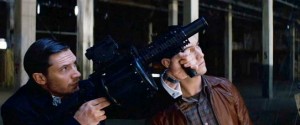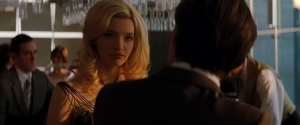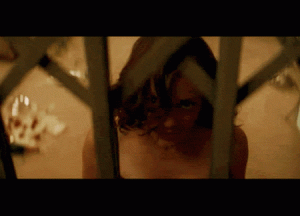Christopher Nolan’s filmography seems “driven by a deep-seated desire to satisfy the so-called ‘masculine malaise’, in which it will be understood that he offers his male (anti-)heroes the fictional means and pathways to ‘un-truths’ to transcend the limitations of their ‘fractured’ male existence” (Deakin 85). The various crises of modern masculinity—a set of problems ill-defined in the concrete but best named as the perception of the loss of masculine power and identity on systemic and individual levels—come to a head for Nolan’s characters. Leonard asserts himself and his right to vengeance in Memento’s anonymized world. Bruce Wayne transcends the confines of his playboy archetype to become a hyper-masculine hero in the Batman trilogy. And Inception’s Dom Cobb seeks to return to being a father but must first overcome his malignant deceased wife,[1] in sum needing to defeat the feminine to reach his masculine destiny. For Cobb, does Deakin’s perspective hold up? Is his ‘masculine malaise’ solved by letting him transcend reality (in whatever sense that word can describe the film) or through another solution?
Answering those questions about Inception’s perspective gender politics requires answering another question first, specifically as to how the camera connects on-screen action to the audience. During dialogue, Nolan likes to shoot from the person talking at the person listening. When the conversation is between Ariadne and Cobb, he portrays them differently. As Ariadne talks, we still see her head in the corner of the shot. But as Cobb talks, he disappears as the camera watches Ariadne. The camera can be construed as coming from the man, but refuses to identify with a woman.
From the opening scene, the movie constructs the world through male eyes. The movie’s starting scene contains a shot of Cobb’s children playing on the beach that reappears marked clearly as his memory later in the movie.[2] This memory returns later in one of the floors of the dream world Cobb enters every night. It also is plucked from the beach and placed into different dream levels during the titular mission to indicate the fragility of his mental state. Only Cobb can see this shot; the movie begins inside his head and with his eyes. In the opening conversation with Saito, the camera does not employ the perspective reversals of Ariadne and Cobb’s conversation. Instead, as the camera switches focus from Cobb to the corporate mogul and back, the camera can legitimately serve as the perspective of either. While Cobb talks, a wine glass ever-so-briefly crosses the shot—an intentional yet subtle acknowledgment of the first-person perspective of the camera. The movie introduces itself as the product of masculine perspectives, and then lets Ariadne in primarily to be observed.
(watch the beginning 35 seconds to see Cobb’s memory; watch closely around 2:24-2:26 to see the wine glass)
If this view of the movie is right, then watching Inception turns its viewers into men, exiting the theater having spent two hours seeing the world as men see it. The consequences of this should be clear. To name them, the movie would have forced audience identification with masculinity, likely in conjunction with perceiving the feminine as simultaneously worse-than-men and dangerous to men, and erecting one more roadblock to female representation[3] in film.
Looking at where the movie doesn’t get dominated by men—where it either takes the camera from masculine perspective, extends it to feminine perspectives, or does both—should indicate the limits (if any) to this Mulvey-esque perception of Nolan’s camera as a fundamentally male gaze. One such example comes from Ariadne’s first dream creation, as Cobb teaches her the tricks of his peculiar trade. As she alters the underlying physics of the dream, she alienates Cobb’s subconscious and its manifestations in ‘projections’ of people. The camera adopts her perspective so it can portray a masculine subconscious directing its antagonism at the camera. If the movie’s perspective indicates a sort of audience alignment with whoever it represents, then Inception would seem to display the fears of women threatened by strangers in public spaces. Sympathy for cat-calling victims seems to be at odds with a masculine-controlled camera. Later in the same scene, the camera ever-so-briefly adopts Ariadne’s perspective again as she is stabbed by Mal. The adoption of the point-of-view shot to witness first-hand violence against women—to make the viewer a victim of phallic violence—seems to indicate a dynamic more complex[4] than the masculine gendering of the camera and bond between it and the audience.
(watch around 1:50-2:05 to see the first set of POV shots; watch around 4:15-4:19 closely to see the second set)
A similar complication comes in the reversal of masculine technique from before. I mentioned the way the camera refused to be point-of-view for certain characters. After entering Cobb’s dreams uninvited, Ariadne discovers his continual engagement with and attempts to fix his past, and challenges him. When she does so, the angle repeats the techniques of prior conversations, but flips the gender of each. The viewer now sees a foregrounded corner of Cobb, preventing the camera from being mistaken for an extension of the scene’s masculine presence. The double-sided deployment of this technique and the allowance of some POV shots to be both feminine and depicting violence against women indicate cracks in a belief of the always-masculine viewer relating to POV as his own. But it doesn’t, and shouldn’t, fully disprove the thought. The broader undermining of this theory of the movie comes from the unmooring of its assumptions of characters’ fixed and easily understood gender roles.
The first challenge for this narrative is the movie’s own Gender-Bender, Eames, who shifts shapes and genders. Within dreams, he serves as both a rich, flushed old man and a pretty young woman, convincing his mark with each. The film places an emphasis on him learning others’ mannerisms in addition to replicating their appearance. Gender fluidity exists because gender is a learned behavior, not a strict one. This both pulls the rug out from understandings of perspective dependent upon rigid gender distinctions; Saito was even fooled by the convincing gender performance of Eames, which nods to the socially constructed role of gender and casts doubt upon masculinity and femininity as occupying two separate, distant planets.[5]

Eames on the left

Eames, again on the left
Eames’ performance moves us closer to a broader gender-bending element of the movie, namely the fact that one of the two women is really just a man. Mal is introduced as an oppositional force to Dom, but later revealed to be a projection of his subconscious. The feminine threat of the film reveals itself as coming from a masculine force. There are a couple implications here that I feel the need to describe. As an initial note, this offers another chance to display gender as performed; Cobb’s subconscious contains a significant feminine presence, which he does not display but does at least possess. The public self can be hyper-masculine while the body still hosts multiple gender identities. Next, this complicates the already mentioned understanding of the stabbing shot of Ariadne. Before, the choice of a woman carrying a knife could be the temporary masculinization of Mal, as the weapon “represents male power and violence” (Indick 39). But the decision to use a knife, a penetrative object, instead of a gun or other weapon, represents the true nature of Mal and reinforces the masculine violence of the phallic stand-in of the POV shot, which certainly discredits any understanding of the viewer as a heterosexual male scopophile. The last note of interest is how this interacts with Deakin’s claims. To him, Mal’s character is the current iteration of Nolan’s “seeming myopic sense of female malignity” (Deakin 93). The movie certainly introduces her that way, but over time her villainy becomes a product of Cobb, as an invention of either his mind or victim of his first attempt at inception. Male mistakes causing guilt in the male subconscious does not seem to be a cause for “female malignity” of any sort.
Don’t believe this? Look to the film’s construction of male nostalgia, which ostensibly provides the emotional charge to Cobb’s goals. He wants the golden-tinged domesticity of his children and his wife, who reappear as a visual reminder of his mental state throughout the movie. But when we get to see his memories played out, as Ariadne joins him in his dream, what shows up doesn’t exactly resemble Cobb’s idyllic home. The elevator that travels through his subconscious has bars for doors—which don’t show up in the elevator in his literal dream home in the semi-purgatorial state of Limbo—even though he created the material substance of the dream. That enables a shot, as Ariadne and Cobb retreat into the elevator, of Mal on the ground, behind bars. Male nostalgia for a domestic past as a prison for women; the camera asks for a recognition of what nostalgic gender politics look like to those who don’t resemble Leonardo DiCaprio.

Prison of male nostalgia
Right after that shot comes the scene where the camera accepts Ariadne’s visual perspective but not Cobb’s. Rather than let the camera return to male perspective, the movie rejects it. That conversation prompts Ariadne’s inclusion in the dream layers for the Inception mission, and she ultimately guides Cobb to a reunion with his children. The solution to crises the movie has revealed as masculine in nature is not Deakin’s “fictional means” or “un-truths” but a practical path: let the one real woman in the story have a role in the decision-making. Allow people to play with gender perceptions. Realize the danger of the femme fatale is a creature of the masculine subconscious. The movie supposedly challenges us to “dream a little bigger, darling”, but it’s only dreaming if the idea of fluid gender roles and substantive feminine representation get read as impossible fantasies, and not a better future.
[1] Helpfully named Mal, her name points to her (potentially) harmful nature from the start of the film.
[2] To clarify, this is a scene chronologically located towards the end of the movie used at the beginning with a recurring shot from throughout added in. Nolan can’t resist rejecting other movies’ Simple Order of chronological shots.
[3] Representation here meaning not the presence of women, which Hollywood already has, but the on-screen portrayal of femininity as something other than the object of male desire or subject of the male gaze.
[4] That is not to say that Mulvey and her advocates’ argument is simple, as much as to say that the actual shots of the film complicate the outlined narrative.
[5] The “boys go to Jupiter to get more stupider” school of thought. Not just a playground taunt, but also a common perception of gender as two strictly defined, strictly separated, definitely-not-overlapping categories.
This essay was written in the style of David Foster Wallace.
Leah Rosenfeld provided feedback.
Works Cited
Deakin, Peter. “Men in Crisis: Christopher Nolan, Un-Truths and Fictionalising Masculinity.” The Cinema of Christopher Nolan: Imagining the Impossible, Edited by Jacqueline Furby and Stuart Joy, Columbia University Press, 2015, pp. 85–98, www.jstor.org/stable/10.7312/furb17396.12.
Indick, William. Psychology for Screenwriters: Building Conflict in Your Script. Studio City, CA: Michael Wiese Productions, 2004. Print.